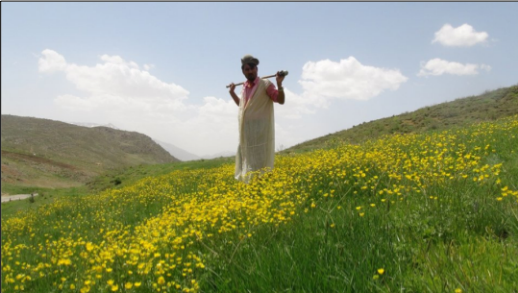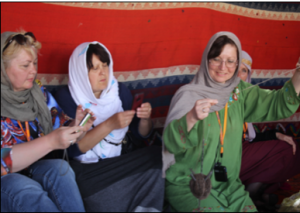First published on 08/29/2015, and last updated on 03/29/2018
By; Laleh Daraie, National Coordinator of GEF SGP Iran in collaboration with Heybatlu Tribal Investment Fund and Center for Conservation of Sustainable Ecosystems
On the road to recognizing ICCAs in Iran, the theme and concept of revival and strengthening of community conserved areas has been supported by the GEF SGP Iran Program since 2001 (including through the ICCA registry). Many examples can be quoted such as: Qeshm Island customary fishing areas and marine life; seasonal wetlands in Caspian rice fields; traditional management of oak forests in the northern Zagros Mountains (Galazani); and local ownership of wetlands network revival around the Urmia dried lake.
As some of the best remaining pasture lands in the country are under tribal structures, re-recognizing pastoralist group identities and working towards restoration of customary laws and management systems has been a primary step, essential to deepening work on ICCAs. A type of formal registration has to also be sought to enable their recognition under the current laws.
In this context, Tribal Investment Funds were set up in the Koushk-e-Zar project with the Kuhi sub-tribe, which belong to the Shishblouki tribe, under the Qashqaï Tribal Confederacy. For the first time the seasonal migratory territory was mapped through PGIS, giving a bone-shaped map. The grantee of GEF SGP Iran’s project was the Center for Sustainable Development and Environment (CENESTA, Member of the ICCA Consortium), which later facilitated the registration of the Union of Indigenous Nomadic Tribes of Iran (UNINOMAD, Member of the ICCA Consortium) and the Tribal Investment Funds. GEF SGP has funded several Tribal Investment Funds for ICCAs, as they are based on indigenous knowledge and customary institutions of environmental governance. These sorts of conservation and livelihoods projects have brought about some hopeful results, among which there is community-based ecotourism in the Heybatlu Sub-tribe of Shishblouki Tribe, Qashqaï Tribal Confederacy. The main successes of this project are that it is now documented by the World Tourism Organization (UNWTO), local monitoring criteria have been developed to link community-based ecotourism to pastureland conservation, job opportunities have been created and the tendency towards migration has been reversed.
In the Heybatlu sub-tribe, the established community Investment Fund of the Council for Sustainable Livelihoods, is headed by a representative of the community Mr. Amiri. The idea of community-based ecotourism came from within the community, drawing on their former experiences in national activities and projects and also the ecotourism potential of the tribal territory, where traditional culture is well-anchored and nature is beautiful. A tourism specialist was invited, Ms. Fereshteh Fazel, who helped focus the community-based ecotourism efforts.
The main goal of the project was to achieve a sustainable livelihood through community-based ecotourism, focusing on ICCAs. The project offers a real example of a nomadic pastoralist lifestyle and its importance and experience in the conservation of nature and biodiversity (flora and fauna), as well as its social and cultural values. In this case, nothing more than a basic livelihood was expected, since the community believes that the preservation of its traditional lifestyle and its related sources of livelihoods is vital to maintain the area as an attractive destination for tourists. The planned activities focused on capacity building, participatory management of natural resources, job creation, wealth generation and revival of ecological and cultural values of their lifestyle as the specific objectives of this project.
The first steps of the project were to nominate Mr. Amiri as head of the Community Fund and community representative. Then, a feasibility study was conducted. Thereafter, during several participatory and consultative meetings, and following the approved methodology, the nationalized pattern of community-based ecotourism was implemented in the Heybatlu sub-tribe. The willingness of local people to develop tourism, the expected participation and the feasibility of levels of participation are factors that helped in making the decision to set up an ecotourism project. Training processes including discovery, dream, design and adjustment were conducted, a brochure was prepared and a website launched. The next stage was the organization of an experimental tour in the region with experts and enthusiasts, to assess the tourism program and its strengths and weaknesses.
- Mr. Amiri, head of community fund and local project manager © GEF SGP Iran
- Foreign tourists learning how to spin © GEF SGP Iran
Meanwhile, community representatives participated in many national and regional meetings, workshops and exhibitions to present their good pioneer practices. It was an opportunity for the community to present the potential of tribal lifestyles for ecotourism, and even to take part in national regulation and decision making sessions. Thanks to this effective advertising, news of the implementation of community-based ecotourism in Heybatlu sub-tribe territory was released through various media (such as in qashqaionline, hamshahri, chn, tnews, to name only a few…) and some newsletters. Following the publication of an article in the “Travel Book”, this initiative was highlighted as one of the 100 top spots for tourism and won the Kinary international prize for tourism. Furthermore, the national organization of cultural heritage and tourism, officially asked for the project story to be considered in the international project of “Tourism Stories” funded and initiated by UNWTO.
Finally, for the first time in the country, the community also monitored and evaluated the project results according to localized indicators, and discussed its strengths and weaknesses together with its success rate. The default indicators for the project were found to be too scientific and therefore impractical for the community, however, they still enumerated the problems of drought, destruction and occupation of migratory routes and the use of mechanized migration. On the other hand, the change in urban migration and the creation of jobs were some of the achievements which the community stressed.
The members of the Heybatlu community are now trying to assimilate their learned lessons to upgrade their experience. They believe that the main priority for community-based ecotourism should be the preservation of customary lifestyles rather than economic gains, otherwise it will fail. They also emphasize the importance of targeting a structured community and associating it with investment or a sustainable livelihood fund, and not only choosing a landscape or geographical tourist area. From their point of view, identifying and having stakeholder groups involved at all stages from preparation to implementation and evaluation, in addition to respecting their independence, are keys to the success of such schemes.
The difference between GEF/SGP projects and conventional government interventions is that the former uses local and indigenous knowledge, encourages local participation, creates networks of cooperation in the local community and produces a significant sense of ownership among all stakeholders. These projects are based on demand, are decentralized, are resilient and are implemented in a friendly atmosphere. They also have participatory-based structures which consist of analysis of feasibility, analysis of stakeholders, status identification, planning, implementation and monitoring. These are the main reasons for the rapid formation and the great efficiency of the local network working on community-based ecotourism in the Heybatlu community.


